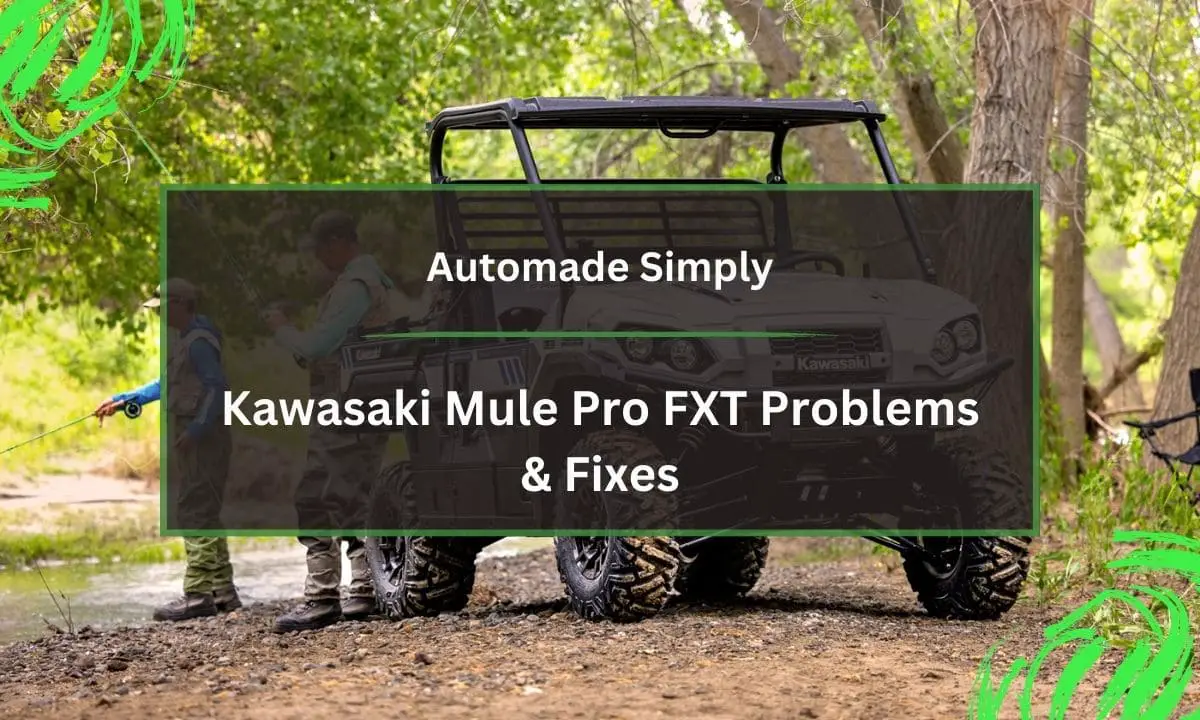Kawasaki Mule Pro FXT Problems & Fixes

The Kawasaki Mule Pro FXT is one of the most popular recreational and utility UTVs (Utility Task Vehicles) on the market today. These side-by-sides are known for their rugged durability and hauling capacity that make them ideal for both work and play. However, like any machine, the Mule Pro FXT can run into issues from time to time. So what are the most common Kawasaki Mule Pro FXT problems, and how can you diagnose and fix them?
The good news is that most Kawasaki Mule Pro FXT problems are relatively easy to identify and address if you know what to look for. In this detailed guide, we’ll walk through the most common issues with the Kawasaki Mule Pro FXT and provide tips to get your UTV back up and running. We’ll cover problems with the engine, transmission, brakes, suspension, electrical system, and more. Whether you want to troubleshoot issues yourself or provide the repair shop with critical details, read on for the knowledge you’ll need to keep your Mule Pro FXT in tip-top shape.
Table of Contents
Introduction to the Kawasaki Mule Pro FXT UTV
Before diving into common problems and fixes, let’s take a quick look at what makes the Kawasaki Mule Pro FXT tick. Kawasaki first introduced the Mule line of utility vehicles back in 1988, and the Mule Pro FXT arrived in 2015 as an upgrade over the standard Mule Pro with enhanced comfort, storage, and towing capacity.
Some key features and specs of the Mule Pro FXT include:
- 812cc 3-cylinder fuel-injected engine – Provides plenty of low-end torque and smooth power delivery.
- Continuously Variable Transmission (CVT) – Offers seamless, variable gear ratios for optimized performance.
- On-Demand True 4-wheel Drive – Allows you to engage 4WD when needed for maximum traction.
- Dump Bed – Hauls up to 1,000 pounds of cargo and flips up for easy unloading.
- 2,000 lb Towing Capacity – Strong enough to tow equipment, another UTV, and more.
- Independent Rear Suspension (IRS) – Soaks up bumps and ruts for a smoother ride.
- Tilting Steering Wheel – Makes getting in and out easier for drivers.
- Digital Instrumentation – Provides key vehicle data to the driver.
With its muscular engine, versatile drivetrain, and rugged chassis, the Mule Pro FXT combines brawny utility with creature comforts for the trail or work site. But even well-designed UTVs experience wear and tear over time. Read on for the most common issues and solutions.
Common Kawasaki Mule Pro FXT Engine Problems
The engine is the beating heart of any UTV, and the Mule Pro FXT’s 812cc three-cylinder powerplant delivers excellent low-end response and plenty of torque for hauling and towing. However, like any engine, it can develop problems after years of use. Here are some of the most common Kawasaki Mule Pro FXT engine issues and how to address them:
Overheating
Excessive engine heat is one of the most serious issues that can affect the Mule Pro FXT. Left unchecked, overheating can lead to blown head gaskets, warped cylinders, and even complete engine failure. Here are some common overheating causes and solutions:
- Clogged radiator – Dust, mud, and debris can block airflow through the radiator, causing coolant to overheat. Carefully clean out the radiator fins with compressed air or a garden hose.
- Faulty thermostat – The thermostat controls coolant flow to the radiator. A stuck closed thermostat prevents cooling, while a stuck open thermostat reduces engine temperature too much. Replace the thermostat.
- Low coolant – The cooling system may have a leak if coolant is consistently low. Visually inspect hoses, water pump, and radiator for leaks. Replace any faulty parts and refill the cooling system with the proper coolant mix.
- Fan failure – Electric cooling fans help pull air through the radiator at low speeds. Test the fan operation and replace the fan assembly if it’s not working properly.
Lack of Power
If your Mule Pro FXT feels sluggish or lacks its normal pep, several issues could be to blame:
- Clogged air filter – A restricted air filter reduces air intake, resulting in lackluster engine performance. Replace the air filter with a new Kawasaki filter.
- Fouled spark plugs – Carbon deposits on the spark plugs inhibit proper firing. Replace the plugs with new ones gapped to factory specifications.
- Fuel system clogs – Gunk in the fuel injectors, fuel filter, or fuel pump can restrict fuel delivery. Run fuel system cleaner through the injectors. Replace fuel filters. Test fuel pump operation.
- Low compression – Worn piston rings, leaking head gasket, or burnt valves reduce engine compression and power. A mechanic can diagnose compression issues through a leak-down or compression test. An engine overhaul may be needed to restore optimal compression.
Excessive Oil Consumption
Burning more than a quart of oil every few hundred miles indicates a problem. Potential causes include:
- Worn piston rings – Piston rings seal the combustion chamber and control oil consumption. Worn rings allow oil to leak past into the combustion chamber. An engine overhaul with new rings will be required to stop the oil burning.
- Faulty valve guide seals – Hardened and cracked valve guide seals allow oil to be pulled into the intake and exhaust valves, where it burns off in the engine. New seals installed by a mechanic will solve the issue.
- Incorrect oil viscosity – Using oil that is too thin can increase oil consumption as it leaks past seals and rings easier. Always use the factory-recommended oil viscosity.
By identifying and addressing engine problems promptly, you can avoid extensive repairs down the road. Pay attention to warning signs like changes in engine sounds, weak performance, and the sudden appearance of new leaks.
Diagnosing Kawasaki Mule Pro FXT Transmission Problems
The transmission takes the torque from the engine and efficiently delivers it to the wheels, so flaws in the drivetrain can impair your Mule’s capabilities. The Pro FXT uses a continuously variable transmission (CVT) for seamless, optimal gearing. Here are a few common CVT problems and fixes:
Hard Shifting
Does the transmission jerk or harshly change gears? Hard shifting points to issues like:
- Clutch cable adjustment – The CVT clutch requires proper cable freeplay. Too much or too little slack in the cable can lead to sudden engagement. Inspect and adjust the clutch cable per factory specifications.
- Worn shift fork – The shift fork slides the drive belt between different CVT pulleys. Excess play in a worn shift fork causes delayed belt engagement. A mechanic will need to inspect the transmission and replace any worn shift fork components.
- Low belt grip – The CVT belt needs proper grip on the pulleys to avoid slippage. A worn belt with hardened rubber may need replacement. Also inspect the CVT clutch plates for excessive wear or dirt buildup and clean or replace as needed.
Clutch Belt Slippage
Does the engine rev higher than normal without a corresponding increase in vehicle speed? This typically indicates the clutch belt is slipping and not fully transferring engine power. Potential causes include:
- Insufficient belt tension – The CVT clutch springs control belt grip and tension. Weak or broken springs can’t properly squeeze the belt. Have a shop inspect and replace any faulty clutch springs.
- Worn clutch plates – Plates that have lost their grooves fail to grip the belt. Replace any excessively worn clutch plates in the CVT assembly.
- Glazed CVT belt – Belts can become glazed from heat and slip as a result. Replace the CVT belt with a new one to restore optimal grip and performance.
- Debris buildup – Mud, dirt, and gunk on the clutch plates or CVT belt can create slippage. Carefully clean plates and belt with proper degreaser.
Catching transmission issues quickly helps prevent worse problems down the road that could require a full rebuild. Listen for sounds like belt squealing, grinding, or whining, which indicate potential CVT problems.
Common Kawasaki Mule Pro FXT Brake Problems and Repairs
The braking system in the Mule Pro FXT uses hydraulic disc brakes to provide strong, consistent stopping power. But brake components still wear out over time and eventually need service. Here are some brake problems to watch out for:
Brake Noise
Do your brakes squeal or grind when applied? Common causes include:
- Worn brake pads – Pads that wear down to the metal backing plate cause a distinctive squealing or scraping sound. Replace worn pads immediately to prevent damaging rotors.
- Contaminated pads – Brake pads with oil, grease, or dirt embedded in them can chatter or squeal. Lightly sanding contaminated pads may help, but replacement is usually required.
- Dust buildup – Brake dust between pad and rotor can cause vibrations and squealing. Clean components with brake cleaner spray. Consider upgrading brake pad compounds if dusting is excessive.
Reduced Braking Power
Brakes that feel soft or need extra pedal effort to stop could stem from:
- Air in brake lines – Air reduces hydraulic pressure. Bleed lines and check for leaks. Ensure the master cylinder maintains proper fluid level.
- Worn pads and rotors – Allowing components to wear too thin results in braking loss. Replace pads and resurface or replace rotors as needed.
- Brake fluid leaks – Leaks in calipers, lines, wheel cylinders, or the master cylinder lead to low fluid and spongy brakes. Identify any external leaks first, then inspect internal seals and piston bores for issues. Replace any leaking parts.
- Contaminated fluid – Moisture-infused brake fluid can boil under heavy braking, resulting in a soft pedal. Flush systems and replace fluid according to maintenance schedules.
Brakes are a critical safety component, so never delay repairs. Address any issues promptly to keep your Mule’s stopping power optimal.
Diagnosing Kawasaki Mule Pro FXT Suspension Problems
The independent rear suspension (IRS) system on the Mule Pro FXT helps absorb bumps and maintain control across rough terrain. But suspension components do wear out eventually. Some common suspension issues include:
Excessively Rough Ride
If your Mule rides rough and bouncy over ground that shouldn’t be that jarring, possible causes can include:
- Low tire pressure – Always inflate tires to the recommended pressures listed on the door sticker. Low pressures allow too much bounce and flex.
- Worn shock absorbers – Shock oil and seals eventually break down, reducing damping performance. Replace worn shocks with new OEM units tuned for your Mule’s weight and cargo capacity.
- Damaged control arms – Hitting obstacles can bend control arm mounts or joints, leading to loose, erratic handling. Inspect control arms for damage and replace any bent parts.
Vehicle Lean to One Side
A UTV that leans or handles unevenly can point to problems like:
- Damaged wheel bearings – Worn bearings allow too much play in the wheel hubs, creating an unstable ride. Replace any rough or loose wheel bearings.
- Broken coil springs – A corner of the vehicle will sag if a coil spring breaks. Replace broken coil springs in the front or rear suspension.
- Shock failure – If a shock loses oil or pressure, that corner will have reduced support. Replace leaking or malfunctioning shocks immediately.
Take time to listen and feel how your Mule handles bumps and cornering. Any emerging handling issues are easier to fix if caught early before severe suspension damage occurs.
Key Kawasaki Mule Pro FXT Electrical System Issues
Like any vehicle, the Mule’s electrical components see a lot of wear and tear leading to eventual issues. Be alert for problems like:
Battery Dies Quickly
If the battery struggles to hold a charge or dies prematurely, suspect causes include:
- Corroded battery terminals – Acidic buildup on the terminals inhibits proper current flow. Clean terminals thoroughly with a wire brush and baking soda solution.
- Faulty stator – The stator recharges the battery when the engine runs. A malfunctioning stator allows the battery to gradually die. Test stator output with a multimeter and replace if needed.
- Old battery – Battery capacity weakens over time after years of use and recharging. Load test the battery and replace if it fails to hold a charge.
Lights Flickering
Electrical connections impact lighting performance. If lights dim or fluctuate, it could indicate:
- Loose or damaged wiring – Inspect wires for deterioration or loose plugs and terminals. Repair or replace damaged wiring as needed.
- Faulty alternator – The alternator recharges the battery and powers lights while driving. Test alternator output and rebuild or replace it if required.
- Bad ground connection – Weak ground connections cause electrical glitches. Clean and tighten chassis and engine ground straps.
Electrical gremlins are frustrating, but methodically testing circuits and components makes diagnoses easier. Consult a repair manual for proper testing procedures if needed.
Additional Mule Pro FXT Problem Areas to Watch For
While we’ve covered the most common problem areas, a few other issues can crop up on the Mule Pro FXT:
- Leaking shock seals – Oil oozing onto the springs indicates blown shock seals. Time to replace the leaky shocks.
- CVT belt failure – Severely worn or snapped CVT belts will leave you stranded. Always carry a spare.
- Fuel pump failure – No start situations sometimes trace to a bad fuel pump. Confirm pump operation with a pressure test.
- Steering wander – Loose tie rods or ball joints allow sloppy steering. Inspect and tighten or replace any worn components.
- Overheating CVT – Stuck in mud or high loads can overheat the transmission. Allow proper cooling or reduce loads/pace if overheating occurs.
The key is addressing any problems promptly to minimize breakdowns on the trails or at the work site.
Conclusion
While the Mule Pro FXT is designed for rugged durability, ongoing maintenance and prompt repairs when issues arise are vital to keeping these UTVs dependable long-term. From cooling system failures to worn brakes to electrical gremlins, identifying and troubleshooting problems using the tips above will help you determine if repairs are DIY-friendly or best left to a professional.
Catch issues before they lead to breakdowns or catastrophic failures. Know the warning signs unique to critical systems like the engine, transmission, suspension and electrical components. And don’t neglect routine maintenance like fluid changes, tire rotations, and brake inspections that can preempt many problems. With a careful eye and prompt response to any emerging issues, your Kawasaki Mule Pro FXT will provide years of off-road fun or dedicated job site service.







